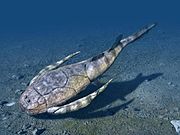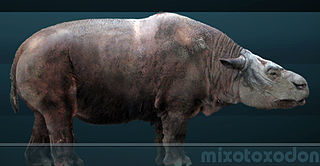
Toxodontia is a suborder of the meridiungulate order Notoungulata. Most of the members of the five included families, including the largest notoungulates, share several dental, auditory and tarsal specializations. The group is named after Toxodon, the first example of the group to be discovered by science.
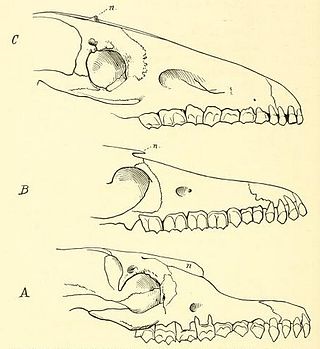
Scalabrinitherium is an extinct genus of mammals of the family Macraucheniidae. Fossils of this animal were found among the fossils of prehistoric xenarthrans in the Ituzaingó Formation of Argentina.
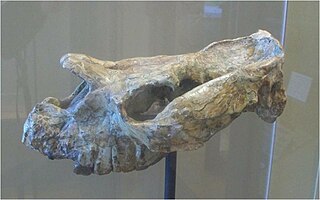
Leontiniidae is an extinct family comprising eighteen genera of notoungulate mammals known from the Middle Eocene (Mustersan) to Late Miocene (Huayquerian) of South America.

Mesotheriidae is an extinct family of notoungulate mammals known from the Oligocene through the Pleistocene of South America. Mesotheriids were small to medium-sized herbivorous mammals adapted for digging.

Mixotoxodon is an extinct genus of notoungulate of the family Toxodontidae inhabiting South America, Central America and parts of southern North America during the Pleistocene epoch, from 1,800,000—12,000 years ago.

Interatherium is an extinct genus of interatheriid mammal from the Early to Middle Miocene (Colhuehuapian-Mayoan). Fossils have been found in the Santa Cruz, Collón Curá and Sarmiento Formations in Argentina.
The South American land mammal ages (SALMA) establish a geologic timescale for prehistoric South American fauna beginning 64.5 Ma during the Paleocene and continuing through to the Late Pleistocene. These periods are referred to as ages, stages, or intervals and were established using geographic place names where fossil materials where obtained.
The Deseadan age is a period of geologic time within the Oligocene epoch of the Paleogene to the Early Miocene epoch of the Neogene, used more specifically within the SALMA classification of South America. It follows the Tinguirirican and precedes the Colhuehuapian age.
The Laventan age is a period of geologic time within the Middle Miocene epoch of the Neogene, used more specifically within the SALMA classification in South America. It follows the Colloncuran and precedes the Mayoan age.

Granastrapotherium is an extinct genus of ungulate mammals, described from remains found in rocks of the Honda Group in the Tatacoa Desert, in the Colombian departments of Huila and Tolima, at the Miocene fossil site La Venta. The only species formally recognized is Granastrapotherium snorki. Remains found in Bolivia and Peru, seem to belong to Granastrapotherium or a very similar animal.

Xenastrapotherium is an extinct genus of astrapothere, a type of hoofed herbivorous mammal, native to South America, which lived in the Middle to Late Miocene period, typically during the Laventan stage. It is a member of the family Astrapotheriidae in the subfamily Uruguaytheriinae, large astrapotheres, equipped with a trunk-like nose and protruding teeth, similar to the elephants, but their tusks were the canine teeth, not the incisors. Xenastrapotherium was a genus widely distributed in northern South America, in contrast to other species of astrapotheres which lived in the area of the Southern Cone of the continent. It differed from other astrapotheres by having two lower incisors on each side of the jaw and the tusks have a pronounced longitudinal curvature, although their general shape and size are probably very similar to Astrapotherium, whose weight would be 900 to 1,500 kilograms, comparable to the current black rhinoceros.
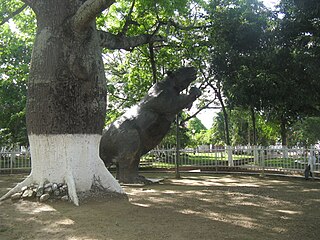
The Honda Group is a geological group of the Upper and Middle Magdalena Basins and the adjacent Central and Eastern Ranges of the Colombian Andes. The group, in older literature also defined as formation, is in its present-day type section in the Tatacoa Desert in the department of Huila subdivided into two main formations; La Victoria and Villavieja.

Miocochilius is an extinct genus of small notoungulate mammals (typotheres) native to South America. The genus lived during the Middle Miocene epoch. The genus contains two described species, the type species M. anomopodus described in 1953 by Ruben Arthur Stirton and M. federicoi, described and included in the genus by Darin A. Croft.
Cullinia is an extinct genus of litoptern, an order of South American native ungulates that included horse-like and camel-like animals such as Macrauchenia. It is only known from fragmentary remains. Cullinia levis is known from Chasicoan remains found in the Arroyo Chasicó Formation of Argentina, and remains from the Brazilian state of Acre and the Huayquerian Ituzaingó Formation have been assigned to Cullinia sp..
Anayatherium is an extinct genus of notoungulate belonging to the family Leontiniidae. It lived during the Late Oligocene, and its fossilized remains were discovered in South America.
Colpodon is an extinct genus of herbivorous mammal, belonging to the order Notoungulata. It lived during the Early Miocene, in what is today Argentina and Chile, in South America.
Coquenia is an extinct genus of Notoungulate, belonging to the family Leontiniidae. It lived during the Middle Eocene, in what is today Argentina.
Martinmiguelia is an extinct genus of Notoungulate, belonging to the family Leontiniidae. It lived during the Middle Eocene, and its fossil remains were found in South America.
Huilabradys is an extinct genus of ground sloths of the family Nothrotheriidae that lived in what is now Colombia. Huilabradys was discovered in the strata of the La Tatacoa desert in the Huila department, in the Villavieja Formation, and is part of the so-called La Venta fauna, a fossiliferous location from the mid-Miocene period that has provided a notable paleontological contribution on the Miocene faunas of northern South America. The remains discovered are basically fragments of the jaws and teeth, allowed the identification of this species, whose only species is Huilabradys magdaleniensis, and was classified as a member of the nothrotheriid subfamily Nothrotheriinae, which comprises small to medium-sized species of ground sloths.






















